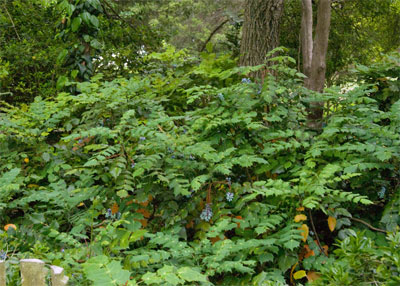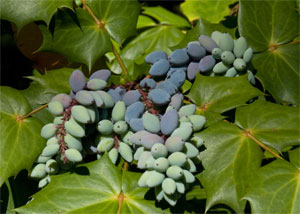From the Sperry Garden – April, 2010


It takes a lot to move me away from hollies when I’m landscaping a part of my total-shade landscape. However, this is a plant that can do that. Oh, it may look like a holly, but it grows like a nandina. And, it should. After all, they’re virtually sisters.
Leatherleaf mahonia, Mahonia bealei, grows to 4 to 6 ft. tall and 3 to 4 ft. wide. It’s very reluctant to branch, so its display is pretty well made up of upright stalks of long leaves prominently displayed to all who pass by. Honestly, that show alone makes leatherleaf mahonias worth the effort, but greenish-yellow flowers appear in mid- to late winter, and those blooms are soon followed by clusters of luscious blue-gray fruit that persist through the spring.
These mahonias are renowned for their durability. Insects and diseases leave them alone, and they’re prickly enough that children and pets stay away from their leaves. But, they’re drought-tolerant, and they’re not especially picky about their soils. Fertilize them several times during each growing season, and keep them modestly moist, and they’ll reward you with handsome and vigorous growth.
About the only pruning I’ve had to do to my 40 or 50 mahonias here and elsewhere in my yard is to remove the few stems that have extended up and beyond all the others – stems that might give the beds an erratic look. That’s rare, however. This bed hasn’t been trimmed in several years. Oh, by the way, as with nandinas, when you prune leatherleaf mahonias, you need to make your cuts either flush with another stem, or fairly close to the ground. Don’t prune them 3 or 4 feet in the air and expect them to look natural afterwards.
This planting doesn’t get as much water as the rest of our gardens, so it doesn’t grow quite as quickly, nor does it bear nearly as many clusters of fruit as my other plantings. But, these plants have been here for at least 25 years. They’ve survived many a drought and water curtailment with scarcely a blemish. The few orange/yellow leaves that you see in this photo taken Monday evening are last year’s foliage that is about to shed to the ground.
This is a great shade plant (turns scorched yellow in sunlight). Give it a try. You’ll be glad that you did.

